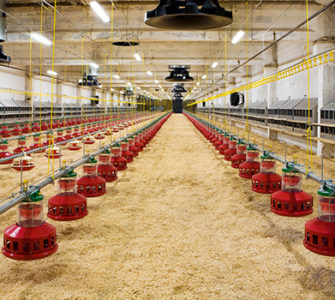Footpad dermatitis a greater concern in chickens grown to older ages
Footpad dermatitis is more likely to be a problem among broilers grown to an older age, but it can be remedied if producers intervene in time, Tom Tabler, PhD, professor with Mississippi State University Extension, told Poultry Health Today.
The major contributor to footpad dermatitis is wet litter, he said. Many companies are growing chickens for 62, 63 or 64 days. “That means the grower has got to take better care of that litter for a longer period of time…as the house fills up and there’s less air flow across the litter, it gets more difficult to keep that litter dry.
“By far, wet litter is probably the biggest thing I worry about,” Tabler continued.
But wet litter isn’t the only cause of footpad dermatitis. Too much ammonia can contribute to the problem and so can the litter’s age and type of litter.
New versus old litter
New litter tends to have sharp edges and rough chunks whereas old litter is easier on the feet, he said. In addition, growers tend not to ventilate as much if they have new litter because ammonia levels aren’t as high.
Among the types of litter used — which include rice hulls, peanut hulls and pine shavings — pine shavings are probably the best for perverting footpad dermatitis, Tabler said. However, the poultry industry competes with other markets for pine shavings and also rice hulls, which drives up their cost.
In addition, the quality of litter probably isn’t as good as it used to be 5 or 10 years ago, he continued. “There may be more sticks and chunks and splinters” that can puncture tender feet, providing an access point for bacteria.
Footpad dermatitis is more often a problem in winter but can be seen in summer, too, especially among chickens near the cool cells, where there’s more moisture.
Risk for all ages
Paw-quality issues can occur in broilers at any age. “I’ve seen litter slicked over by the time those chickens were a week old. Again, if you’ve got wet litter on a baby chicken, you’re going to have paw damage. If you’ve got wet litter on a market-age chicken, you’re going to have paw damage,” Tabler said.
If baby chicks have paw damage, there’s time to fix the cause and improve paw condition. That may be improving ventilation or whatever else caused wet litter.
“Now, you may not clear up all the damage because you could look at a footpad that’s had a lesion on it that’s healed up and you can tell at one time or another something was there. But given enough time, and given the right conditions, you can fix a lot of dermatitis issues,” he said.
In market-age birds that develop footpad dermatitis, producers probably don’t have time to correct the problem. The better plan is to provide floor conditions that ensure chickens have healthy footpads whenever they go to market, Tabler said.
Posted on July 26, 2018

















